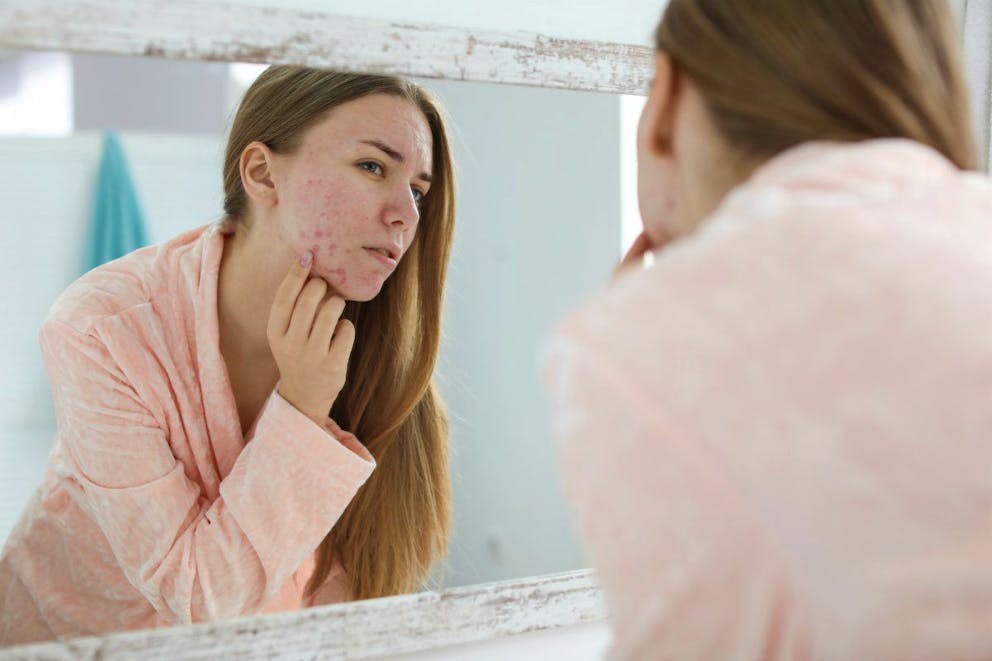9 Diabetic Skin Problems That Indicate Diabetes
9 Diabetic Skin Problems That Indicate Diabetes
Have you ever found yourself staring at your reflection, puzzled by the sudden appearance of skin problems? It's not just you. Millions are on the same boat, navigating through a sea of creams and treatments with hope fading like sunset hues.
What if the troubles with our skin were murmuring intimate details about our well-being? Yes, those annoying blemishes might be more than skin-deep.
Imagine finding out that a cluster of new freckles or an uninvited rash could be nature's way of flagging down issues hidden beneath the surface—like trouble with blood sugar levels.
There is no horror story here; just cold, hard facts wrapped in human biology. Conditions such as acanthosis nigricans or those pesky skin tags might have ties to something bigger: diabetes.
The twist? Knowledge is power. Understanding this connection can turn despair into action and confusion into clarity.
Understanding Diabetic Skin Problems
If you think diabetes is about blood sugar and insulin, add another layer to the story: your skin. Yep, that's right. Your body's largest organ can show signs when your glucose levels are low.
The Connection Between Insulin Resistance and Skin Health
Have they ever noticed dark patches on someone's neck or underarms? That could be acanthosis nigricans talking. The skin says, “Hey, we’ve got too much insulin around here.” And those tiny skin tags popping up?
They're not just random; they also chat about what’s happening inside.
Insulin resistance affects more than just our energy levels—it also affects how our skin functions. So, if you see these changes, it might be time to talk with your doctor about blood sugar.
The Impact of High Blood Sugar on Skin Integrity
Elevated glucose doesn’t play nice with our bodies—especially our skin. Think of high blood sugar as an unwanted guest that overstays its welcome, causing chaos along the way:
Petechiae & Purpura: These aren't fancy French desserts but are tell-tale red spots signaling trouble beneath the surface.
Gangrene: As grim as it sounds, this severe complication means tissues have thrown in the towel due to lack of proper circulation and infection control—a dire warning sign for anyone managing diabetes.
Sky-high sugar levels damage blood vessels, making it difficult for wounds to heal properly or fight off infections effectively.
This isn't meant to scare but rather inform because knowing is half the battle in managing diabetic symptoms, including those that affect skin integrity.
Common Diabetic Skin Conditions
Diving into the world of diabetes is not just a game of numbers; your skin tells its own story, revealing an array of conditions that demand attention.
It's not just about the numbers on your glucose monitor; it's also about what you see in the mirror. Diabetes can be a bit of a drama queen when it comes to your skin, introducing an entourage of conditions that could use some spotlight.
Acanthosis Nigricans
You know those dark, velvety patches in skin folds? That’s acanthosis nigricans. More than just a quirky name, it signals insulin resistance—a key player in type 2 diabetes.
Often showing up where you least expect it—neck, armpits, groin—it’s like your body is trying to tell you something.
Skin Tags and Diabetes
Have they ever noticed those tiny flaps of skin that seem to pop up out of nowhere? Yep, we're talking about skin tags. While they might seem harmless (and let's face it—quite weird), they're linked with higher insulin levels.
Think of them as little flags raised by your body to say, “Hey, watch out for your blood sugar.”
Digital Sclerosis
Nope, this isn’t about digitizing sclerosis for the digital age. If only.
This condition means thickening or hardening the skin on fingers or toes due to—you guessed it—diabetes again playing havoc with insulin levels, making things stiff and rougher than usual.

Acne and Insulin Levels
Last but not least: acne. Yes, even zits have made their way into this narrative because why should teenagers have all the fun? Increased insulin levels mess with hormones, which can lead us down breakout boulevard, especially if PCOS is part of your story, too.
In short, your skin tells tales more intriguing than any book ever could, particularly when diabetes enters stage left (or right). But don't fret; understanding these signs gives us power over our stories. And who doesn’t love having a bit more control?
Serious Complications and Advanced Symptoms
Diabetes isn't just about keeping an eye on what you eat or pricking your finger; it can get severe fast. We're talking about skin complications that don't just itch or annoy but can genuinely threaten your well-being.
Gangrene and Diabetes
Picture this: a part of your body, like a toe, turns red to black. That's gangrene for you - as severe as it sounds. It happens when blood flow takes a nosedive, leaving tissues dead in its wake.
And with diabetes ramping up the risk factor due to poor circulation and high sugar levels wreaking havoc on blood vessels, attention is not just recommended; it’s crucial.
If left unchecked, amputation might become part of the conversation. No one wants that. So, keeping tabs on changes in skin color or sensitivity isn’t overreacting—it’s brilliant.
Leg Ulcers in Diabetic Patients
Moving down the leg, ulcers are not allowed to walk in the park either. They pop up uninvited when diabetes messes with circulation and leaves your immune system hanging—not quite able to fight off infections like before.
Poor circulation? Check.
Infection-prone wounds? Double check.
The kicker here is foot care becomes paramount—think daily inspections to catch anything out of the ordinary early because these ulcers have a knack for getting worse before they get better.
Battling them involves keeping sugar levels under control first and foremost because let's face it: Uncontrolled diabetes is like adding fuel to the fire.
Treating these conditions right away saves toes and improves the quality of life—and I’m all about maintaining both at their peak. So remember, folks, pay close attention to those feet; they carry you through life.
Lifestyle Changes for Managing Diabetic Skin Problems
So, you've got diabetes, and your skin's acting up. What now? Before you freak out, let me tell you about some non-medical tricks that could help keep those pesky skin problems at bay.
Importance of Diet in Managing Insulin Resistance
Eating right isn't just about keeping the pounds off. Regarding diabetes, what’s on your plate matters much more than you might think. Switching to a diet low in carbohydrates can significantly alter the playing field, especially when dealing with diabetes.
Cutting down on carbs helps manage insulin levels, and guess what? Tweaking your carb intake could give your skin that extra glow you've been chasing.
Intermittent Fasting's Role
Have you ever heard of intermittent fasting? It’s not just another fad diet; it's a legit way to improve insulin sensitivity. Cycling between eating and fasting gives your body a chance to reset its insulin response—like hitting the refresh button.
Natural Alternatives for Blood Sugar Management
Apple Cider Vinegar: This kitchen staple does more than add zing to your salads – it may also help lower blood sugar levels after meals.
Berberine: Ever heard of this plant-based powerhouse? Berberine has been shown to help control blood sugar, making it an excellent ally in managing both diabetes and related skin issues.
The bottom line is simple: with these lifestyle tweaks, we can better control our blood sugar and potentially dodge those annoying diabetic skin problems. Remember, though, always chat with your doctor before trying something new—they know best.
Recognizing Early Signs of Diabetic Skin Issues
Let's get real for a second. If you or someone close to you is juggling diabetes, skin problems might not top your list of concerns. But here's the thing - they should.

Swollen, Puffy Eyelids as a Warning Sign
You wake up, glance in the mirror, and there it is - those puffy eyes staring back at you. It might just be a stormy sleep night. Wrong. If this becomes more like your daily greeting, it could signal something deeper: fluid retention linked to diabetes.
This isn't about vanity; it’s about vigilance. Swollen eyelids can be an early alarm bell that your body is waving frantically to get your attention.
Identifying Petechiae and Purpura
Next up on our skin detective journey are petechiae and purpura—it sounds fancy, but trust me, these are guests we'd rather not host.
Petechiae: These tiny red or purple dots pop up uninvited when blood vessels under the skin break due to high sugar levels messing with circulation.
Purpura: Similar vibe but bigger blotches join the party here because why keep things simple?
Catching these signs early isn’t just playing doctor; it’s taking charge before things escalate into complications nobody wants on their plate.
The takeaway? If diabetes is part of your life story, keep an eye out—literally—for any unusual changes in your skin tone or texture. It's way more than superficial; it could be vital to steering clear of more significant issues down the road.
Learn more about managing diabetic skin conditions here.
Conclusion
So, there you have it. A deep dive into the hidden messages your skin might send about diabetes without uttering a single word:
Acting as silent sentinels, these manifestations hold the line on our well-being's front lines, beckoning us to intervene before our situation deteriorates.
It's easy to brush off that new rash or those stubborn skin tags as mere annoyances. But in reality, they're part of a bigger narrative - one where our body constantly communicates with us, trying to get our attention amid the noise of daily life.
The connection between skin issues and blood sugar levels isn't just fascinating; it's a crucial piece of knowledge that can empower us on our journey toward better health.
By paying close attention to what our skin tells us and taking proactive steps in managing diabetes, we're not just treating symptoms—we're embracing an approach that looks after our well-being holistically.
Understanding the messages our skin sends us goes beyond worrying about each spot or scar.
It's about understanding the intricate ways different aspects of your health are interconnected—because knowledge isn't just power; it’s protection, prevention, and peace of mind all rolled into one.
We've unpacked some truths today—truths too significant to ignore. Your skin doesn’t lie; it offers clues worth exploring for anyone willing to listen closely enough—and act accordingly.
And remember: while creams may temporarily fade surface-level imperfections, natural beauty lies in tackling underlying challenges head-on because of this battle? It’s more than winnable—it’s yours for the taking.
Supporting Data
https://www.ncbi.nlm.nih.gov/pmc/articles/PMC5336429/
https://ojs.library.queensu.ca/index.php/pocus/article/view/13316/8714
Previous blog
The #1 Best Food for CoQ10 (Coenzyme Q10)
Popular
08/21/2024
55.7K views
02/23/2025
46.8K views
11/18/2024
281.1K views
03/18/2024
11/21/2022




